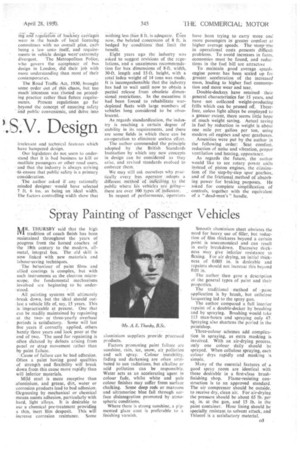Spray Painting of Passenger Vehicles
Page 81

If you've noticed an error in this article please click here to report it so we can fix it.
MR. THURSBY said that the high tradition of coach finish has been maintained throughout the years of progress from the horsed coaches of the 18th century to the modern, allmetal, integral bus. The old skill is now linked with new materials and labour-saving techniques,
The behaviour of paint films and allied coatings is complex, but with such instruments as the electron microscope, the fundamental mechanisms involved are beginning to be understood.
All painting systems will ultimately -break down, but the ideal should out-last a vehicle life of, say, 15 years. This is impracticable at present. One that can be readily maintained by repainting at the twoOf three-yearly overhaul .periods is satisfactory. Some will last five years if correctly_ applied, others .barely three years and look poor at the end of two. The need for repainting is often dictated by defects arising from panel or strap movement rather than by paint failure.
Cause of failure can be bad adhesion. Often a paint having good qualities of strength and flexibility will break down from this cause more rapidly than will inferior materials.
Mild steel is more receptive than aluminium, and grease, dirt, water or corrosion products lead to bad adhesion. 'Degreasing by mechanical or chemical means assists adhesion, particularly with hard, light alloys. It is desirable to use a chemical pre-treatment providing a thin, Inert film desposit. This will increase corrosion resistance. Some
aluminium suppliers provide processed products.
Factors promoting paint failure are sunshine, rain, ice, snow, air pollution and salt spray. Colour instability. fading and darkening are often attributed to sun radiations, but alkaline or acid pollution can be responsible. Water acts as an accelerating agent in colour fade, whilst white and pale colour finishes may suffer from surface chalking. Some deep reds or maroons and ultramarine blue fail through surface disintegration promoted by atmospheric conditions.
Where there is strong sunshine, a pigmented glaze coat is preferable to a finishing varnish.
Smooth aluminium sheet obviates the need for heavy use of filler, but reduction of film thickness beyond a certain point is uneconomical and can result in early breakdown. Excessive thickness may give inferior resistance to flexing. For air drying, an initial thickness of 0.005 in. is desirable and repaints should not increase this beyond 0.01 in.
The author then gave a description of the general types of paint and their properties.
The traditional • method of paint application is by brush, but cellulose lacquering led to the spray gun.
The author compared a full interior repaint of a double-decker by brushing and by spraying. Brushing would. take 113 man-hours and spraying only 47. Spraying also shortens the period in the paintshop.
Three-colour schemes add complication in spraying, as extra masking is involved. With an air-drying process. only one colour daily should be sprayed. When cellulose spraying, each colour drys rapidly and masking is simple.
Many of the essential features of a good spray room are identical with those desirable in a first-class brushfinishing shop. Flame-resisting construction is to an approved standard. The air compressor should be outside, to receive dry, clean air. For air-drying the pressure should be about 65 lb. per sq. in. at the gun, and 15 lb. in the paint container. Hose lining should be specially resistant to, solvent attack, and Thioeol is a satisfactory material.




































































































































































































